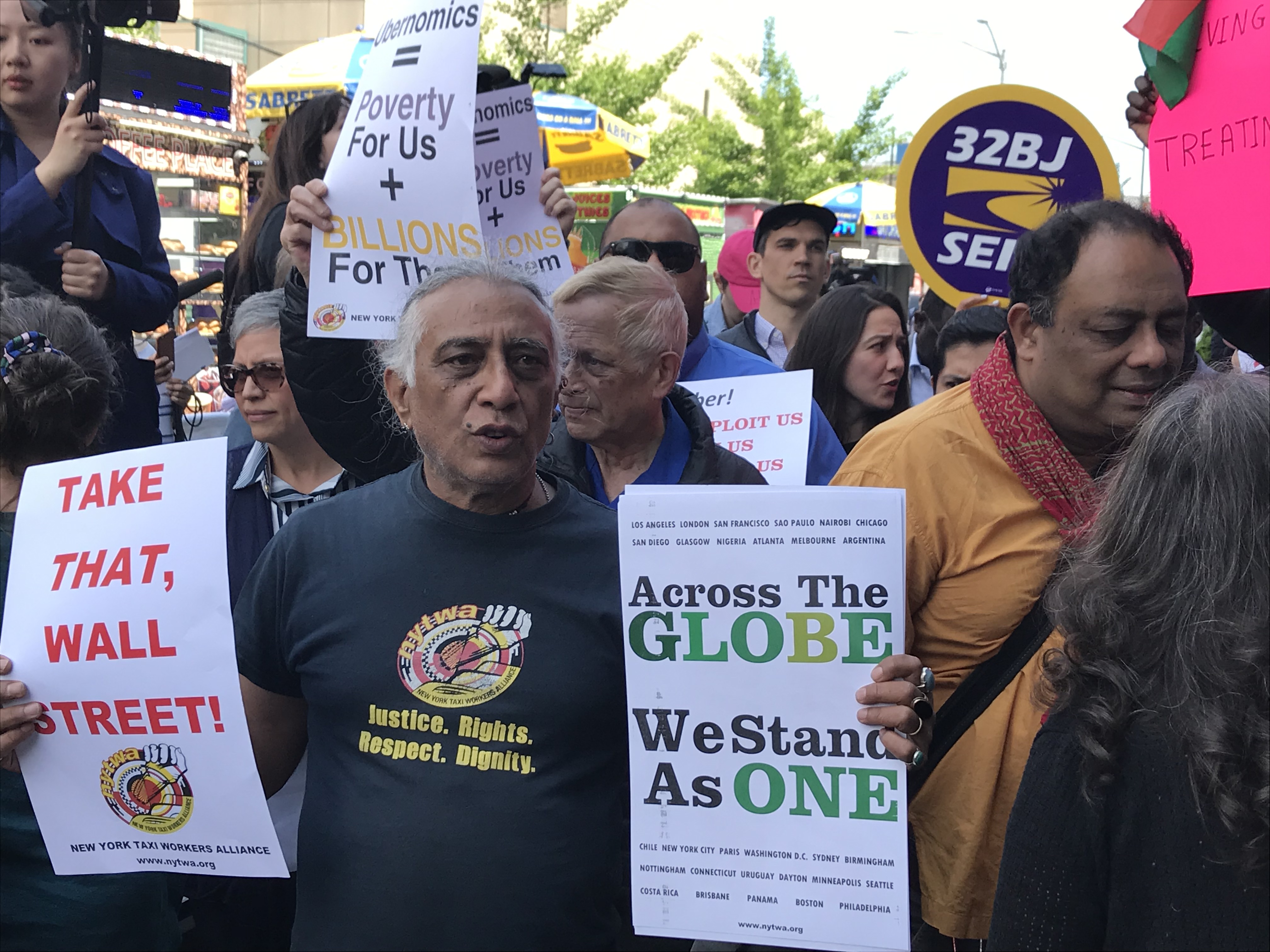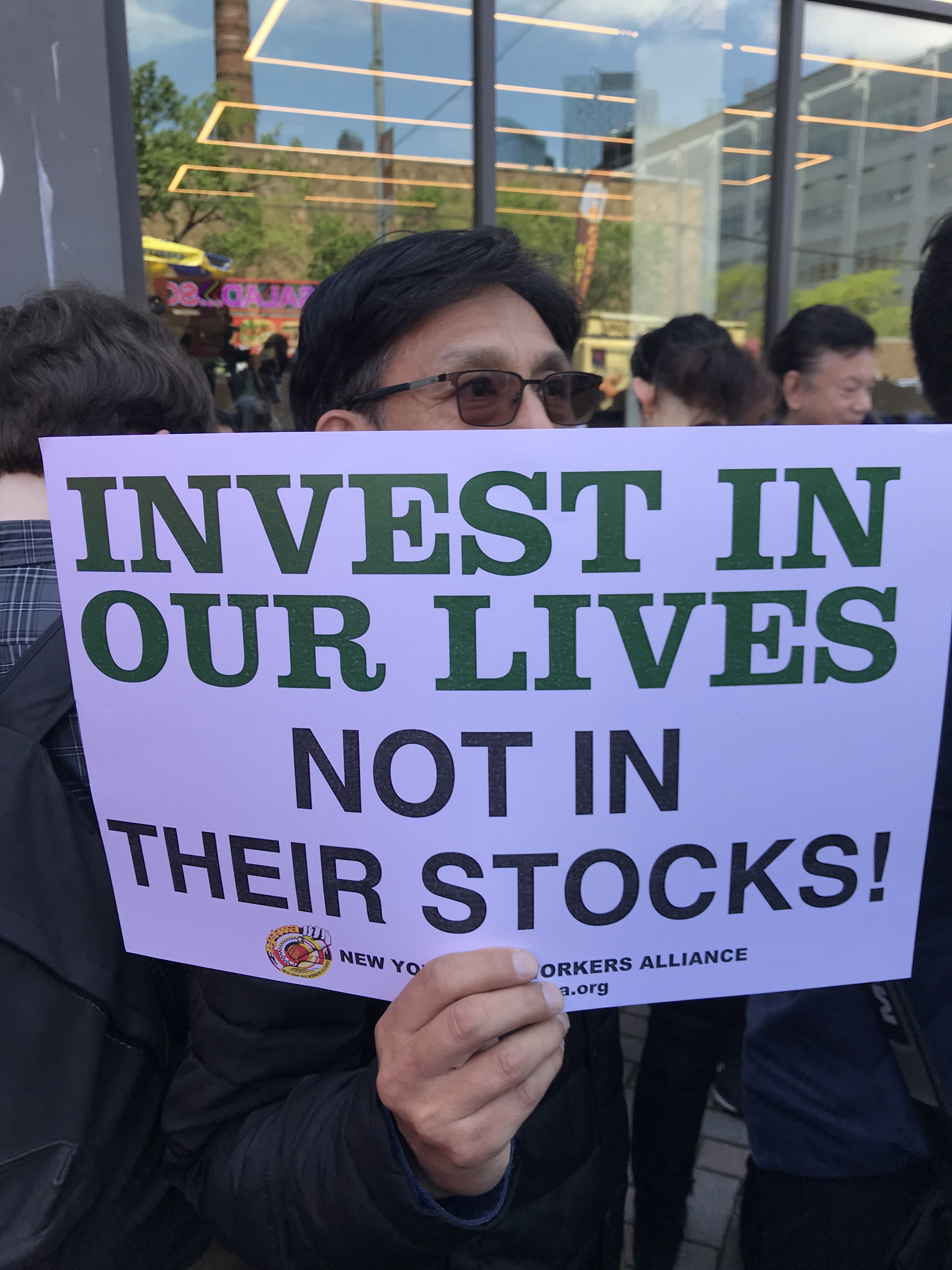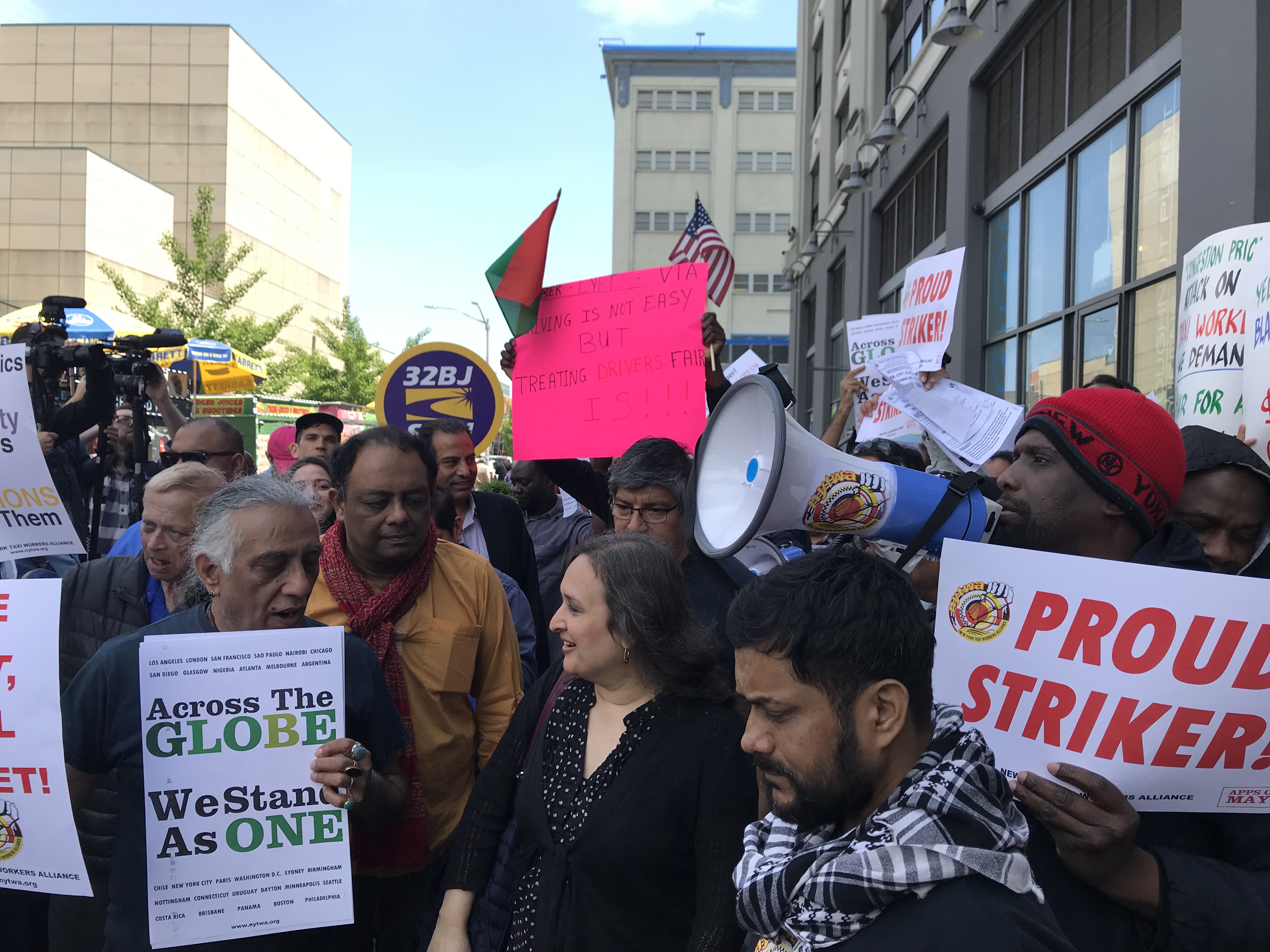NEW YORK, N.Y.—On a day when app-based drivers walked off the job in cities from Los Angeles to London, about 100 New York drivers rallied outside the Long Island City building that houses offices of Uber, Lyft, and the city Taxi and Limousine Commission.

The May 8 strike, with drivers in about 10 U.S. cities logging off Uber, Lyft, Juno, and Via for periods of one to 24 hours, came on the eve of Uber’s initial public offering, in which the company hopes to sell $100 billion worth of stock. New York City drivers, who logged off from 7 to 9 a.m., had three main demands: End unfair deactivations, end “the scam of upfront pricing”—Uber’s system of charging riders a flat rate in advance, but not giving drivers a cut of the profits if they complete the trip more quickly—and regulate fares and limit the companies’ commissions so 80-85% of the fare would go to the driver.
“We want to say to Uber, Lyft, and their Wall Street backers that this is just the beginning,” New York Taxi Workers Alliance head Bhairavi Desai told the rally, in police pens between the building and a row of halal food trucks on 47th Avenue. “The beauty of this strike is unprecedented for people who work in isolation.”
She disputed Uber’s contention that only about 500 drivers had participated, saying that intersections normally packed with for-hire vehicles during the morning rush hour had none.
Issa Gadiaga, an immigrant from Burkina Faso who has worked 12-hour shifts six days a week for Uber and Lyft for the past year, carried a sign that read “Uber-Lyft-Via: Driving is not easy, but treating drivers fair is!!!”
Drivers in Los Angeles and San Diego organized by Rideshare Drivers United turned off the apps for 24 hours beginning at midnight, with pickets at both cities’ airports. In San Francisco, Gig Workers Rising led a 12-hour strike that began at noon, with a rally at Uber headquarters. Drivers in Boston, Philadelphia, and Atlanta protested at Uber Greenlight and Lyft hubs, and held rallies in downtown Chicago and at Washington’s Reagan National Airport.
Connecticut Drivers United delivered a letter to the Uber Greenlight hub in Stamford demanding that the company drop its opposition to a state Senate bill that would limit commissions to 25% and prohibit retaliation against drivers who organize. “Uber already kicked us off their property but we are right in front!” the group posted on Facebook at 11 a.m.
“We’re witnessing a historic moment,” AFL-CIO President Richard Trumka posted on Twitter. “Be a part of it, show your solidarity, and don’t cross the picket line.”
Uber did not respond to a request for comment from LaborPress. Desai accused the company of “broken promises” that condemned drivers to “poverty and debt.”
When app-based services arrived in the city in 2011, they lured a lot of former yellow-cab drivers with the promise of more money. Varinder Kumar, a yellow-cab driver since 1992, signed up with Uber in 2014 because he was tired of how much medallion owners were charging him to lease a taxi.
But with the app companies lowering fares, increasing their commissions, and bringing in thousands of new drivers, wages have plummeted. “They put out so many cars, the business was depleted,” says Uber driver Inder Parmar. He shows pay stubs indicating that he made $37 an hour before vehicle expenses in 2014, grossing more than $2,200 for a 60-hour week. In the week ending May 6, he worked 19 hours and grossed $92—less than $5 an hour.
He says he’s lucky he got a job as a private chauffeur, so he only has to work for Uber for supplemental income.

Lyft said in a statement that its drivers’ hourly earnings “have increased 7% over the last two years, and they have earned more than $14 billion since we launched. Over 75 percent drive less than 10 hours a week to supplement existing jobs. On average, Lyft drivers earn over $20 per hour.”
A 2018 study by the Economic Policy Institute estimated that Uber drivers made less than $11 an hour after company fees, vehicle expenses, and self-employment taxes—below the minimum wage in nine of 20 major markets, including New York, Los Angeles, and Chicago. While most drivers were part-time or quit after a short period, it added, there was “a core group who are full-time and year-round workers who provide a large share of the services.”
A growing concern for drivers is being “deactivated”—fired. Drivers are increasingly deactivated, cut off from access to the app, “without notice, without cause, and even without appeal,” Desai told the rally.
“I went to the office, and they didn’t have any kind of answer,” says Varinder Kumar, deactivated by Uber last December for an unspecified safety reason after 4½ years on the app.
“I don’t know what kind of safety reason,” says Baljeet Singh, who has driven for Uber, Lyft, and Via for 3½ years, but was cut off from airport trips. “They don’t explain it.”
That is exacerbated by that many drivers buy vehicles that meet app companies’ specifications in order to work. “They encourage us to buy a new car,” said Bhuchung Bista, 51, a Tibetan immigrant from Jersey City who Uber deactivated last September after two years on the job. “They get a complaint from one customer, and there goes our income.”
“Lyft is OK, not bad,” he says, “but so many drivers have the same problem. They listen to the passengers, not to us. We should be heard. There’s no justice, no hearing.”
The number of drivers deactivated has increased “dramatically” in the last few months, NYTWA organizer Biju Mathew told LaborPress. He wonders if it’s related to pressures to cut costs with the IPO impending. He suspects Uber and Lyft “spinning the revolving door faster” to get rid of full-time drivers.
“They want part-time drivers because they won’t complain about low rates,” Mathew says.
In the S-1 forms Uber and Lyft filed with the Securities and Exchange Commission before their initial public offerings, both companies indicated that they were losing money—$7 billion over the past two years for Uber, $1.6 billion for Lyft—and that if courts ruled they could no longer classify workers as independent contractors, that would cut into the possibility of them ever becoming profitable.

Both companies, which control about 90% of the app-based taxi market, have settled multiple lawsuits alleging that they misclassified drivers as independent contractors out of court.
Classifying drivers as employees, Lyft said, could cause harm to its business, financial condition, and “our reputation and brand.” Its liabilities could include having to pay minimum wage, overtime, and taxes; fines for failing to do so; “claims for employee benefits, social security, workers’ compensation, and unemployment”; and “claims under laws pertaining to unionizing, collective bargaining, and other concerted activity.”
“Uber unabashedly states that denying workers of basic employment protections like minimum wage, Social Security contributions, and other benefits is essential to their business model,” NYTWA and the striking unions in Los Angeles, San Diego, Chicago, Boston and Washington said in a joint statement. “At their core, their business models are based on impoverishing workers.”
“We are contractors. We contribute to this business. We invest in this business,” George Coly, an Uber and Lyft driver nattily turned out in a black leather cap and paisley tie, told LaborPress. “We need to be fairly paid.”



